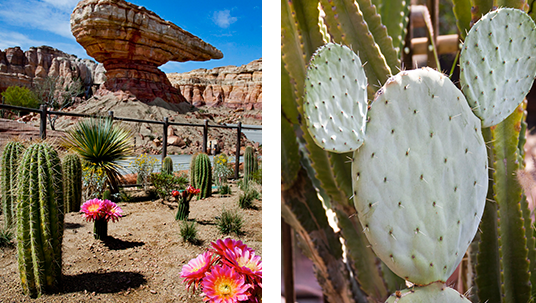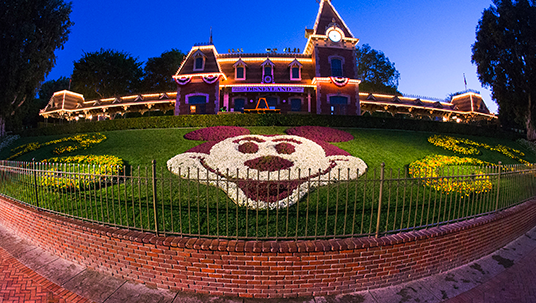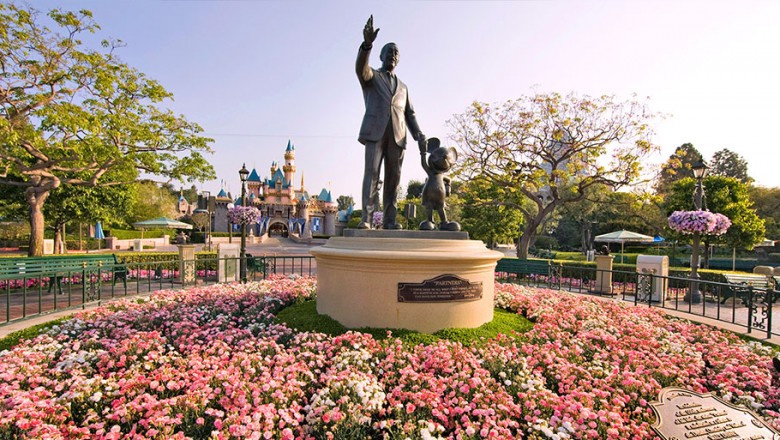Spring has finally sprung! And Disney fans who have spent the last few months staring at white blankets of snow can now begin to fill their gardens with the vibrant colors of spring flowers and foliage. But what if you don’t see “green” when you look at your thumb? D23 went to an expert at Disneyland—sure, we think of it as the Happiest Place on Earth, but we also believe that when it comes to landscaping, Disneyland is one of the most gorgeous places on earth. We spoke with Disneyland Horticulturist Ryan Childs to hear his suggestions for how you can turn your own garden into your own personal “picture spot.”
D23: What’s the first thing someone should think about when planning a spring garden?
Ryan Childs (RC): Color scheme. You know the old saying, “less is more”? This is actually very true. Rather than plant an entire rainbow, we usually only go with about three colors together because the more you add, the more your eye gets confused and it starts losing impact. When we’re working with color, usually we’ll pick two complementary colors—like purple and yellow—because each naturally makes the other color stand out. Then we’ll throw in an accent color, like pink, for example. If you plant with just those three colors in one particular spot, it’s a much stronger statement than if you do all 27 colors that a flower comes in. It’s a little more focused.
D23: Are there other things to keep in mind when you’re choosing combinations of plants to place alongside one another?
RC: We take texture into account. For example, begonias have shiny, waxy leaves. Rather than finding another plant that looks similar and using that, try adding something totally different, texture-wise, like a grass or something spiky. You could have something spiky, something with big leaves, and maybe a mossy kind of thing. Put those together in a grouping combination, and all of a sudden the textures really make the other things stand out and pop!

D23: What can you suggest for people who live in areas experiencing drought, who are trying to not water their gardens or lawns as much?
RC: That’s a question that everybody is dealing with in this day and age. There are actually a lot of really fun plants that don’t require as much water. There’s a whole line of succulents and cactus—all kinds of funny shapes, different colors—it’s a really expanding market right now. Aloes are a type of succulent. There are some aloes that bloom and they get these big spikes of flowers that are starting to come in all different kinds of colors now. There’s some really drought-tolerant grevillea, which is a great genus of shrubs that come in all shapes and sizes. Some get really big—we’re talking about 20-feet-tall—and then some are just little two-foot plants. Those use very little water, yet provide great screening and great backgrounds for a planting. We use those here at the Park.
D23: Tomorrowland, at Disneyland, is known for having a large number of plants that are edible. What plants can you recommend that do “double duty” and look nice, but also could possibly make it to the table?
RC: We use a lot of citrus in Tomorrowland. There’s a shrubby kind of citrus, called calamondin, which looks almost like a kumquat but it’s a little more sour. You would use it in preserves or something like that. We use that as hedging over near Buzz Lightyear Astro Blasters; and Star Tours;. There are also dwarf pomegranates—we use those in Autopia; as hedging or shrub planting. They produce edible fruit on a bush that only gets to be maybe five feet tall.

D23: Of course, when we think of flowers at Disneyland, the Mickey Mouse flower “portrait” comes to mind. Could a Disney fan be ambitious enough to make their own Mickey Mouse garden in their yard?
RC: It’s fairly high maintenance—we end up changing it about every eight weeks or so. It would be helpful to put in some kind of plastic or bender board for edging, to keep the shape. You also really want to use short, tidy plants, like alyssum or violets—smaller flowers. If you’re looking for a mass, the smaller the flower, the more it’s going to read like a painting than individual blobs.
D23: Speaking of maintenance, once a garden is planted, how do we keep it looking as magical as the gardens always look in a Disney park?
RC: You don’t want to water in the evening, because then the leaves will usually sit wet most of the night, and that’s a great way to encourage disease to get started. Early in the morning would probably be best. And for most flowering plants, it’s best to water deeper a little less often than to do a bunch of really shallow waterings if you want to encourage the roots to keep on going down. That way they’ll last through drought and heat better. And the other thing—especially if you’re planting annual flowers—it’s best to use a planting fertilizer with them or lightly feed them afterwards. Find a product intended for flowers and follow the directions on the package. There are some really great slow-release fertilizers that you can add to the soil as you’re planting and then they can feed for months.


